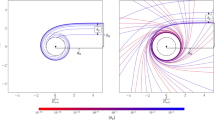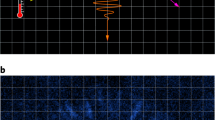Abstract
RECENT astrophysical observations1,2 have raised doubts as to whether the large redshifts of distant galaxies (the Hubble redshift) are due entirely to cosmological expansion. The strongest argument3 in favour of cosmological expansion is that there is no known hypothesis consistent with the laws of physics (other than the Doppler shift hypothesis) that can explain the observed redshifts. An alternative explanation—a gradual energy loss of photons due to their interaction with curved space-time—is considered here. The basic premise is that because photons have a finite spread they are subject to tidal stresses and that this provides a mechanism for the transfer of momentum from the photon to the mass producing curved space-time. Any transfer of momentum without an equivalent transfer of energy will destroy the concept of the photon as a single elementary particle. It is therefore postulated that the interaction of the photon with curved space-time causes it to lose energy in the form of very low energy secondary photons. As well as providing an explanation for the Hubble redshift this hypothesis can also explain the solar limb effect, that is, the increasing redshift of solar spectral lines as the viewpoint approaches the limb of the Sun.
This is a preview of subscription content, access via your institution
Access options
Subscribe to this journal
Receive 51 print issues and online access
$199.00 per year
only $3.90 per issue
Buy this article
- Purchase on Springer Link
- Instant access to full article PDF
Prices may be subject to local taxes which are calculated during checkout
Similar content being viewed by others
References
Field, G. B. in IAU Symp. No. 63 (ed Longair, M. S.) (Reidel, Dordrecht, 1974).
Burbidge, G. R. Nature 246, 17–25 (1973).
Field, G. B., Arp, H. & Bahcall, J. N. The Redshift Controversy, 82 (Benjamin, Reading, Massachusetts, 1973).
Felice de, F. Gen. Rel. Gravit. 2, 347–357 (1971).
Misner, C. W., Thorne, K. S. & Wheeler, J. A. Gravitation (W. H. Freeman, San Francisco, 1973).
Sandage, A. & Tamman, G. A. Astrophys. J. 197, 265–280 (1975).
Field, G. B. & Perrenod, S. C. Astrophys. J. 215, 717–722 (1977).
Adam, M. G. Mon. Not. R. astr. Soc. 119, 460–474 (1959).
Plaskett, H. H. Mon. Not. R. astr. Soc. 163, 183–207 (1973).
Higgs, L. A. Mon. Not. R. astr. Soc. 121, 421–435 (1960).
Plaskett, H. H. Mon. Not. R. astr. Soc. 179, 339–350 (1977).
Allen, C. W. Astrophysical Quantities 3rd edn (Athlone, London, 1973).
Sadeh, D., Knowles, S. & Au, B. Science 161, 567–569 (1968).
Ball, J. A., Dickinson, D. F., Lilley, A. E., Penfield, H. & Shapiro, I. I. Science 167, 1755–1757 (1970).
Goldstein, R. M. Science 166, 598–601 (1969).
Merat, P., Pecker, J.-C. & Vigier, J.-P. Astr. Astrophys. 30, 167–174 (1974).
Fürth, R. Phys. Lett. 221–223 (1964).
Stephenson, L. M. Nature 204, 1179–1180 (1964).
Gillieson, A. H. Can. J. Phys. 43, 57–73 (1965).
Proisy, P. C.R. hebd. Acad. Sci. Paris B 265, 1145 (1967).
Mo, T. C. & Papas, C. H. Phys. Rev. D3, 1708–1712 (1971).
Crawford, D. F. Nature 254, 313–314 (1975).
Author information
Authors and Affiliations
Rights and permissions
About this article
Cite this article
CRAWFORD, D. Photon decay in curved space-time. Nature 277, 633–635 (1979). https://doi.org/10.1038/277633a0
Received:
Accepted:
Published:
Issue Date:
DOI: https://doi.org/10.1038/277633a0
Comments
By submitting a comment you agree to abide by our Terms and Community Guidelines. If you find something abusive or that does not comply with our terms or guidelines please flag it as inappropriate.



